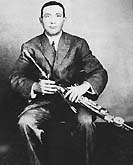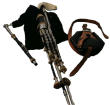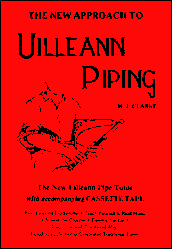
Return to Pre-1920s Home
| History |
Uilleann pipes
date back to the early 18th century and are native to Ireland and
England. Since then, they have become strictly an Irish instrument
as they did not survive in England. It is said they almost became
extinct but regained popularity in the early 20th century. Today,
uilleann pipes are enjoyed throughout the world, mainly in Ireland,
North America, and Europe. The bag is inflated while attached to only one arm. This is why they are called "uilleann" pipes; uilleann means "elbow" in Irish. |
 Patsy Tuohy. Famous early 1900s Irish-American uilleann piper. |
| What
are Uilleann pipes? |
The pipes' design
consists of three drones and three regulators. They are technically
bagpipes, but are nothing like the "Highland Bagpipes" we associate
with kilts and parades. Uilleann pipers do not wear kilts. Uilleann pipes are usually no louder than a fiddle. Their unique design allows for a wider range than any other type of bagpipe. The bag is inflated with a bellows instead of with breath. This is what makes reaching the higher octave possible. Because of the range of uillean pipes, they are now used for any genre of music such as rock and jazz. |
 |
| How
are Uilleann pipes played? |
Uilleann pipes
are played sitting. The bag is inflated with a bellows attached to
one arm. The chanter plays the melody. There are usually three drones
which may be switched on or off while playing. There are also three
regulators (pipes which overlay the drones) that harmonize with the
chanter and drones. |
 |
| Can I learn how to play? | With two full
octaves (unlike any other bagpipe) and many idiosyncrasies, the uilleann
pipes are considered very difficult to play. If you are up for the
challenge, here are some resources: http://www.uilleannobsession.com/links_schools.html http://www.angelfire.com/va/traditionalmusic/resources.html |
 |
| Other Interesting Sites: | http://www.uilleann.com/links.html Na Píobairí Uilleann, (The Uilleann Pipers) |
Listen to a sample on the Seth Gallagher (pipe maker) website. |